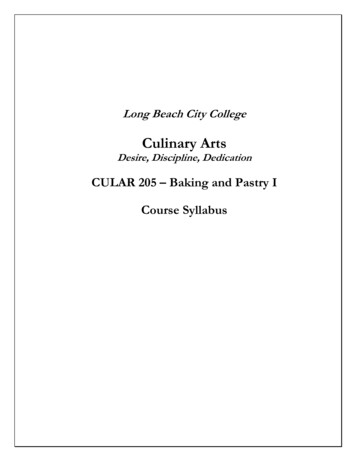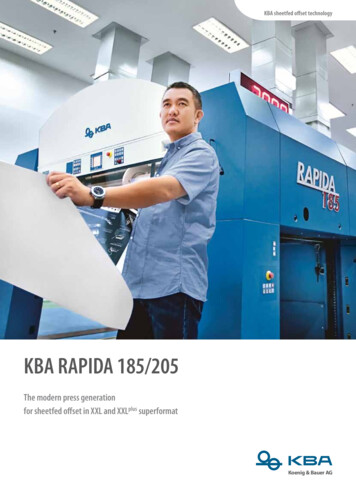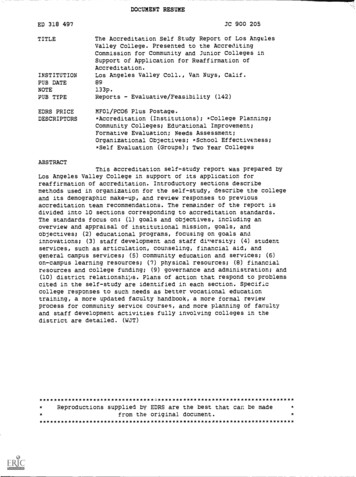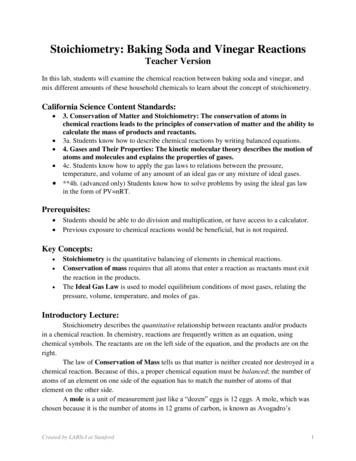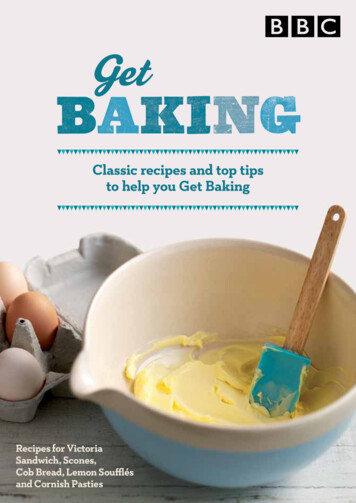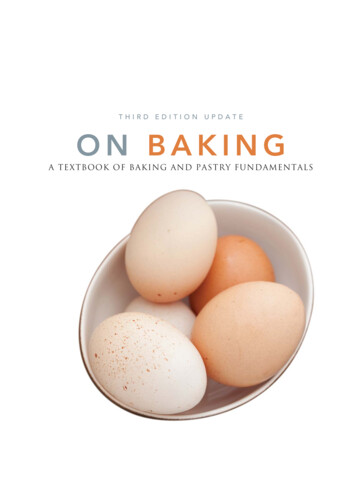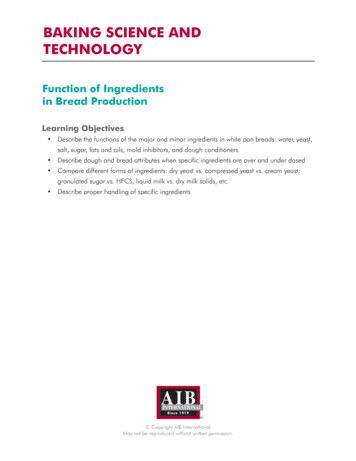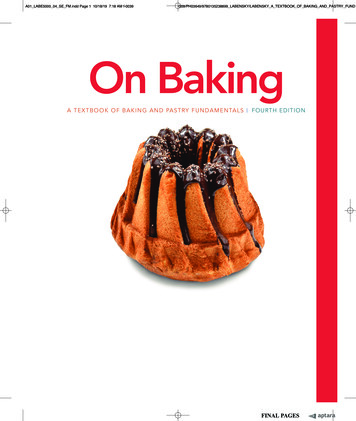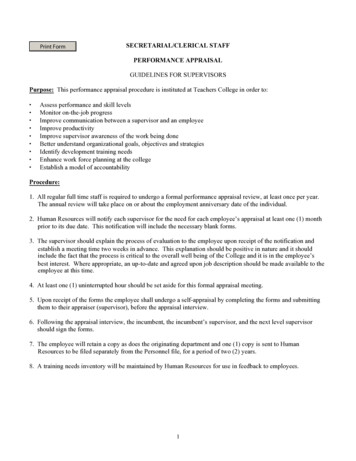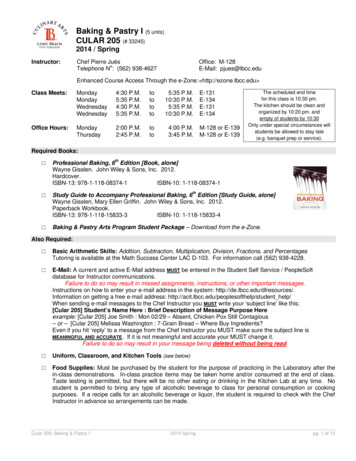
Transcription
Baking & Pastry I (5 units)CULAR 205 (# 33245)2014 / SpringInstructor:Chef Pierre JuèsTelephone No: (562) 938-4627Office: M-128E-Mail: pjues@lbcc.eduEnhanced Course Access Through the e-Zone: http://ezone.lbcc.edu Class Meets:MondayMondayWednesdayWednesday4:30 P.M.5:35 P.M.4:30 P.M.5:35 P.M.totototo5:35 P.M.10:30 P.M.5:35 P.M.10:30 P.M.Office Hours:MondayThursday2:00 P.M.2:45 P.M.toto4:00 P.M.3:45 P.M.E-131E-134E-131E-134M-128 or E-139M-128 or E-139The scheduled end timefor this class is 10:30 pm.The kitchen should be clean andorganized by 10:20 pm. andempty of students by 10:30Only under special circumstances willstudents be allowed to stay late(e.g. banquet prep or service).Required Books: Professional Baking, 6th Edition [Book, alone]Wayne Gisslen. John Wiley & Sons, Inc. 2012.Hardcover.ISBN-13: 978-1-118-08374-1ISBN-10: 1-118-08374-1 Study Guide to Accompany Professional Baking, 6th Edition [Study Guide, alone]Wayne Gisslen, Mary Ellen Griffin. John Wiley & Sons, Inc. 2012.Paperback Workbook.ISBN-13: 978-1-118-15833-3ISBN-10: 1-118-15833-4 Baking & Pastry Arts Program Student Package – Download from the e-Zone.Also Required: Basic Arithmetic Skills: Addition, Subtraction, Multiplication, Division, Fractions, and PercentagesTutoring is available at the Math Success Center LAC D-103. For information call (562) 938-4228. E-Mail: A current and active E-Mail address MUST be entered in the Student Self Service / PeopleSoftdatabase for Instructor communications.Failure to do so may result in missed assignments, instructions, or other important messages.Instructions on how to enter your e-mail address in the system: http://de.lbcc.edu/dlresources/.Information on getting a free e-mail address: http://acit.lbcc.edu/peoplesofthelp/student help/When sending e-mail messages to the Chef Instructor you MUST write your ‘subject line’ like this:[Cular 205] Student’s Name Here : Brief Description of Message Purpose Hereexample: [Cular 205] Joe Smith : Mon 02/29 – Absent, Chicken Pox Still Contagious– or – [Cular 205] Melissa Washington : 7-Grain Bread – Where Buy Ingredients?Even if you hit ‘reply’ to a message from the Chef Instructor you MUST make sure the subject line isMEANINGFUL AND ACCURATE. If it is not meaningful and accurate your MUST change it.Failure to do so may result in your message being deleted without being read. Uniform, Classroom, and Kitchen Tools (see below) Food Supplies: Must be purchased by the student for the purpose of practicing in the Laboratory after thein-class demonstrations. In-class practice items may be taken home and/or consumed at the end of class.Taste testing is permitted, but there will be no other eating or drinking in the Kitchen Lab at any time. Nostudent is permitted to bring any type of alcoholic beverage to class for personal consumption or cookingpurposes. If a recipe calls for an alcoholic beverage or liquor, the student is required to check with the ChefInstructor in advance so arrangements can be made.Cular 205: Baking & Pastry I2014 Springpg. 1 of 13
Tuberculosis (TB) Test (PPD Skin Test:It is required that every student participating in Culinary Arts submit a current Negative TB Test Result on the FIRSTDAY of CLASS. Test results are valid for one year.If you had a TB Test last semester, make sure to submit a copy of your results to your Chef Instructor. If you did nothave a TB Test last semester, you need to get one, as soon as possible. You may have your own Doctor perform thetest. Or, a Nurse at LBCC Student Health Services can administer the test for approximately 10, but an appointmentmust be made in advance: (562) 938-4210.Remember to return to the Doctor/Nurse’s office within 48 to 72 hours for a reading of your test.TB Clearance is a Requirement for this course. Before being allowed to participate in Kitchen Labactivities, you will need to submit a copy of your negative test results to your Chef Instructor.Food Allergies and Food Intolerances:Long Beach City College Culinary Arts Departments recognizes that a relatively small number of students suffersevere allergic reactions and intolerance to one or more commonly eaten foods. The Culinary Arts Department usesfoods most commonly associated with allergic reactions such as, but not limited to: peanuts, nuts in general, sesameseeds, fish and shellfish, wheat, soy(a), milk, and eggs.Students with known Food Allergies must immediately notify their Chef Instructor of their specific Food Allergy.Classroom Tool Requirements:ItemScantron # 815 for Section TestsScantron # 825 for Mandatory Culinary Arts Dept. Safety & Sanitation QuizScantron # 882 for Midterm & FinalNotebookPens, Pencils, and Permanent Markers (Sharpies)CalculatorElectronic ScaleCameraUniform Requirements:Quantity112222ItemWhite Cloth Cook’s / Baker’s BeanieWhite NeckerchiefWhite Cook’s Jacket – Long SleeveCheckered Slacks – Traditional CutWhite Full Bib Aprons with TiesWhite TowelsWork ShoesKitchen Tool Requirements:Quantity111111111111111ItemChef’s KnifeParing KnifeSerrated Edge KnifeVegetable Peeler6" to 8" Offset Pastry Spatula18" Pastry BagPiping Tip: Large RoundPiping Tip: Large Star1½" Pastry BrushBench ScraperRubber ScraperApple CorerPair of ScissorsProfessional Knife/Tool BagHand Whisk, Medium SizedKnife Blade Guards for each knifeBand AidsPairs of Plastic Surgical GlovesA Tool Kit is availablefrom Chefs’ Toys.Please see ordering infoon the e-Zone.Plus:105Students must bring their tools to each and every class meeting, unless otherwise instructed.Cular 205: Baking & Pastry I2014 Springpg. 2 of 13
Suggested Tools / Supplies / Actions:ItemPadlock for Student Lockers (1st come, 1st served basis)Your Name Engraved on all ToolsYour Name on all Uniform Pieces and TowelsOne Possible Name Label Source:25 Sew-on or Iron-on Name Labels for 5.00 Shipped http://www.bestnametape.com/name-tape-labels/ Any ‘no name’ towels or uniforms left after class will beappropriated for in-class use by the Culinary Arts Dept.Course Description: This 5 unit course provides a study of Pastry and Cake Making, covering the techniques and methods for thepreparation of different Cakes, Sponges, Mousses, Cream Fillings and Icings, Tarts, as well as FrenchPastries, Classical Cakes, and an introduction to Candy Making, while giving the student both theunderstanding and intermediate skills they need to progress and develop in a successful baking career. This course is primarily a hands-on, laboratory course. Each class meeting the students spend approximately4 hours in the Instructional Kitchen applying the concepts and principles introduced in the lecture portion ofthe course. At the beginning of each Lab session there will be demonstrations to illustrate the differentprocedures and techniques applied to create the different items we will be studying. The students areexpected to complete a project during each lab session, actively practicing the skills taught in the lesson.Course Outline: During the course of the class there will be lectures and videos on the following topics: Pastry Equipment;Ovens and Tools; Raw Materials and Semi-Finished Products; Sponges and Meringues; Classical Creams;Icing and Decorating Cakes; French Pastry Making; Custards; and the Proper Handling of Puff Pastry Dough. Students will develop the Basic Skills of Baking and Pastry, including Preparation of Cakes, French Pastries,Doughs, Chocolates, Petit Fours, Tarts and Tartlets, as well as be introduced to Special Diet requirementssuch as Low Fat and Gluten-Free. Students will also develop knowledge of Supplies, Hygiene and Sanitation, Safety Practices, and EmployerEmployee Relations. Students may participate in field trips, and guest speakers may visit the program.Student Learning Outcomes demonstrate an overarching understanding and/or application of a core subject aspect:At the end of the course, you will be able to: Prepare different Doughs and Sponges. Demonstrate Piping Skills. Assemble Classical Cakes. Perform the different Cake-Mixing Methods. Prepare French Pastries and Chocolate Candies.Learning Objectives the specific small pieces of subject matter that the students are expected to master, which build-up to the learning outcomes:At the end of the course, you will be able to: Demonstrate preparation technique for Génoise, Sponge Cake, Pie Dough, Sweet Dough, and Pâte Brisée,which are the Basic Sponges and Doughs used in Baking and Pastry Preparations. Master Piping Techniques including the Knowledge and Understanding of When and How to use the ProperPiping Tips. Write and create Decorations with a Paper-Piping Cornet. Prepare various styles of cakes such as Black Forest, Opéra, Tiramisu, Sachertorte. Prepare the appropriate Fillings and Icings for the different Cakes. Explain the qualities of properly constructed cakes, and correct any cake failures or defects. Assemble French Pastries, including Pâte à Choux, Tartlets, and Mousses. Compose Chocolate Candies using different techniques including: Molded, Hand-Shaped, Piped, and Cluster.Student Responsibilities: Participation (see below) Homework (see below) Portfolio (see below) Quizzes, Tests & Exams (see below) Students must inform the Chef Instructor immediately of any Food Allergies or Intolerances. (see below) Tuberculosis (TB) Test (PPD Skin Test) (see above) Students are responsible for dropping themselves by the appropriate deadlines. (see below) Students must adhere to the Culinary Arts Personal Hygiene and Uniform Code (see below) Each student must report to class on-time, suited and booted, and ready to go. Every minute wasted is aminute not learning or baking. On the last day of class, students must remove their locks and personal property from lockers.(Campus Security will cut the locks and place all personal items in storage if lockers are not vacated.)Cular 205: Baking & Pastry I2014 Springpg. 3 of 13
Participation: Quietly Watching and Listening to Lab Demonstration is Mandatory. Any students failing to do so will beDismissed, resulting in a loss of points for the day (see Attendance Policy below). Student participation in breakfast, lunch, and dinner banquets/events are a course requirement; these mayoccur during a weekend at an on- or off-site facility. At the end of the lab session, Clean-Up is required of all students. Chef of the Day (see below)Attendance Policy: Students who are absent in excess of 20% of the total class hours (6 absences) or for two consecutiveweeks (4 classes in a row) may be dropped from class. (See the 2013-2014 General Catalog, pg. 23.) All students must sign-in and sign-out on the daily attendance sheet.Failure to do so will result in no points for the day, No student may sign-in or out for another student.When signing in and out, the student must accurately indicate the time. It is forbidden to write down a timeother than the actual time (e.g. leaving at 9:00 a.m. but signing out for 12:00 p.m.). You will obtain five (5) points at each class meeting for punctual attendance and good conduct (see ClassroomStandards Policy below); two (2) points will be deducted each time you arrive late, two (2) points will be deductedeach time you leave early, and five (5) points will be deducted each time you leave the Lab withoutpermission or “disappear” after the Lecture.Homework: Weekly Textbook Reading (to be done in advance of class as preparation for the lecture) Study Guide Chapters Writing Assignments – A Rubric with Guidelines will be issued when Assigned in Class. Portfolio / Journal Students will be asked to do comparison-shopping, pricing, and quality research in different stores/markets.Textbook Assignments:Students will be responsible for reading the following chapters in the Textbook: Professional Baking, 6th Edition andcompleting the corresponding chapters in the Student Study Guide according to the Course Schedule. (see below)12 Basic Syrup, Creams and Sauces17 Assembling and Decorating Cakes14 Pastry Basics20 Custards, Puddings, Mousses15 Tarts and Special Pastries24 Chocolate16 Cake Mixing and Baking27 Baking for Special DietsLab Work:You will receive a maximum of fifteen (15) points for the completion of each Lab Project. Each project will beevaluated for the following: Completion in a timely manner Quality of work (e.g. size, doneness, taste, texture, overall appearance, consistency, following demonstrated guidelines, etc.)When a Rubric is used, you will have a “Point Conversion Factor” / “Multiplier” that will be used to make the Rubrictotal fit the 15-point daily scale.Portfolio:The portfolio will be a reference guide for the future. The students create a reference and a learning tool that willserve them within and beyond the scope of this course. It is an organized presentation, proof of the student’seducation, work samples, skills and abilities, as well as a tool to track personal development.The Portfolio’s Physical Attributes: A 3-Ring Binder with 5 Divider Tabs (one for each Section); Every page in its own Page Protector All Work/Each Entry needs to be TypedThe Portfolio’s Content should be Personal and Contain at the Minimum (but is not limited to): The Recipes and Procedures for Every Product Learned in Class Key Points and Procedural Notes that are Helpful and which can Guide the Students Through Each Item’sProduction when they are Away from School, whether it is the next day or 5 years after finishing the course. A Picture (Photograph or Drawing) of each Final Product with Descriptions (can also include IntermediateSteps the Student thinks it are Helpful and/or Necessary). The Student’s Evaluation on the Finished Product: Did the Recipes work as expected? Why or why not? Would you have done anything differently? Could you have Substituted other Ingredients? The Chef Instructor's Critique and the Student’s Reflections on the Chef Instructor’s Critique. Anything else the student feels would enhance the Portfolio’s value as a reference and learning tool.Portfolios will be checked periodically at random, which means that the Portfolio should always be up-to-date.Cular 205: Baking & Pastry I2014 Springpg. 4 of 13
Quizzes, Tests, and Exams: Culinary Arts Department Safety and Sanitation Test (multiple choice & short answer — Scantron # 825) Homework Quizzes (short answer) Section Tests (true/false & multiple choice — Scantron # 815) Mid-Term - Written (true/false & multiple choice — Scantron # 882) Mid-Term - Practical/Competency Final - Written (true/false & multiple choice — Scantron # 882) Final - Practical/CompetencyHomework and Test Policy: To receive full credit, all Homework Assignments, Projects, and Papers must be turned in at the beginning ofclass period on the due date. Do NOT submit Homework Assignments, Projects, or Papers via fax or e-mail, they will not be graded. Specific requirements for Projects and Papers will be available on the course website. Keep a digital copy of all Projects and Papers. Failing to complete Homework Assignments, Projects, and Papers will have a negative effect on your grade. Quizzes, Tests & Exams (including the Final Exam) must be taken on the assigned date to receive a grade. If you have any questions or need assistance with homework assignments, please ask your Chef Instructor.Missed Quizzes, Tests & Exams: There are no make-up Quizzes, Test, or Exams.Late Work: Late Homework Assignments, Projects, Paper, and Portfolios will not be accepted.Turn it in on-time or don’t turn it in at all.Extra Credit: There are very few opportunities for earning Extra Credit, and will be offered at the Chef Instructor'sdiscretion, not at the students’ request.Grading Policy:EvaluationCompletion of Laboratory ProjectsAttendance & ConductProfessional Hygiene & Dress CodeHomework QuizzesSection TestsWritten Assignments (e.g. Research Paper, Portfolio)Midterm Exam & CompetencyFinal Exam & CompetencyTotalAB1350-15001200-1349CD# 9 % of Final Grade30%10%10%10%10%10%10%10%100%F0-899A certificate will only be issued to students who maintain a minimum of a “C” average and complete all assignments.Chef of the Day:While in the laboratory, one student will be Chef of the Day.The Chef of the Day is responsible for making sure that: Every Student Signs In and Signs Out All Tables are Clean All Shelves Under the Tables are Clean All Sinks are Clean and Empty All LBCC Equipment is Clean, Dry and Put Away in its Proper Storage Place: Frying Pans on the Bottom Shelf Pots Sheet Pans Containers Trays Kitchen Aid Mixers and their Attachments (checked in according to the list)Cular 205: Baking & Pastry I2014 Springpg. 5 of 13
Personal Hygiene:A personal hygiene code is in effect in institutional kitchens with the following requirements:Jewelry: All jewelry (except a plain wedding band) including necklaces, rings, watches, bracelets, and body jewelry (forexample: nose rings, facial piercings, body piercings, etc.) are not to be worn on campus or at worksites whilein uniform. Long Beach City College is not responsible for lost or stolen articles, so it is suggested that you leave yourjewelry at home.In order to provide a safe and sanitary learning experience, the National Restaurant Association’s ServSafe PersonalHygiene Code is strictly enforced:Remove jewelry prior to preparing or serving food or while around food preparation areas. Jewelry canharbor microorganisms, often tempts foodhandlers to touch it, and may pose a safety hazard aroundequipment. Remove rings (except for a plain band), bracelets (including medical information jewelry),watches, earrings, necklaces, and facial jewelry (such as nose rings, etc.) (reference pages 4-8 of theNational Restaurant Association’s Education Foundation ServSafe Coursebook, 2nd Edition).Fingernails: Fingernails must be clean at all times, and should be of a moderate length with no fingernail polish.Uniform Code: A clean and neat appearance is a must at all times. All students are required to be dressed in complete uniforms, with proper identification (LBCC Culinary Artsstitched emblem) when attending class and off-site locations (such as field trips and worksites). All studentsshould be “suited and booted” before entering the classroom and the Kitchen Lab. Uniforms and aprons must be clean and without stains. Ball caps, scarves, and other hats are not to be worn while in uniform. A Complete Uniform is: Hat Neckerchief Jacket Slacks – properly hemmed & belted at the waist, NOT dragging on the floor Apron Work Shoes At the beginning of the semester, students who come to class not wearing their complete uniformafter the Grace Period will not be allowed to attend class. During the Grace Period, those students who are awaiting delivery of their uniforms should wear clothing asclosely representing their uniform as possible: Hat or Hair Covering Long Sleeved Shirt Slacks – NOT dragging on the floor Apron Non-slip, closed-toe shoes Aprons and/or side towels are not to be worn in the following situations: when visiting to the restroom when discarding garbage when entering or leaving the kitchen area while eating mealsShoes: Shoes should be slip-resistant (non-skid), spill-resistant, flat, black, sturdy work shoes, made of non-porousmanmade materials or leather. Steel-toed shoes are recommended.Any other shoes, such as high heels, open-toed shoes, and sneakers are not permitted.Hair: Hair must be neatly maintained, cleaned, and properly restrained at all times. All hair must be worn above the collar (hairnets). Ponytails should not be visible and must be restrained. If you wear a mustache, it must be kept neatly trimmed and must not extend below the corners of your lips. Beard snoods must be worn over beards. The rest of your face must be clean-shaven daily.You will obtain five (5) points at each class meeting for Personal Hygiene and Uniform (see above); two (2) points will bed
Feb 04, 2014 · The Culinary Arts Department uses foods most commonly associated with allergic reactions such as, but not limited to: peanuts, nuts. in general, sesame seeds, fish. and . shellfish, wheat, soy (a), milk, and . eggs. Stud
